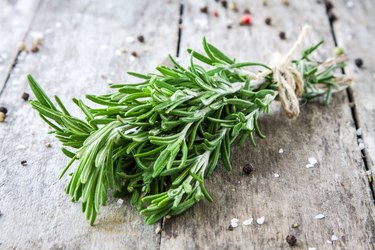
Rosemary (Salvia rosmarinus, USDA zones 7-11) is generally easy to grow, but sometimes it can have problems, including yellowing leaves. To track down the cause of yellowing leaves on a rosemary plant, check which leaves are yellow. If only some of the leaves are yellow, the problem may be different than if all are yellow.
Also check if the leaves are completely yellow or if they have a speckled appearance, which may provide another clue. Proper care of your rosemary plant may be able to save it. If not, knowing what the problem was can help you to have a healthy plant next time.
Video of the Day
Video of the Day
Tip
Common causes of yellowing leaves on a rosemary plant include nutrient deficiencies, root rot, pest infestation and insufficient light.
Rosemary Nutrient Deficiency
A lack of necessary nutrients can cause a rosemary plant to have yellow leaves. The most common cause of yellow leaves is a lack of iron, but the problem may also be caused by insufficient nitrogen, zinc or manganese. If the problem starts on young leaves and spreads to the old ones, it's likely an iron deficiency. If the first leaves to turn yellow are the oldest ones, it could be nitrogen, zinc or manganese that's missing.
What your rosemary plant may need to correct nutrient deficiency is fertilizer, and the only way to determine this is to have the soil tested. If soil-test results indicate the need for fertilizer, only apply it while the plant is actively growing during the warm months. In the absence of a soil test, use a general-purpose water-soluble fertilizer such as 20-20-20 with micronutrients and follow all label directions for mixing rates and reapplication intervals.
If the soil pH is too high, iron may be present in the soil but your rosemary won't be able to use it. Check the soil pH with a test kit or pH probe. If your soil pH is 7.0 or higher it is too alkaline, and you might need to adjust the soil pH.
Other imbalances that can cause trouble with the uptake of iron include too much copper, phosphorous, zinc, calcium or manganese. Too little potassium in the plant and too little iron in the soil will also turn leaves yellow. Repot container plants to resolve such problems and follow soil-test recommendations when fertilizing in-ground plants.
Root Rot and Water Problems
Root rot is a common reason for a yellowing rosemary plant. If your plant has this condition, you'll see stunted yellow leaves as well as overall stunted growth. Rosemary prefers dry, well-draining soil, and too much water can trigger root rot.
Take a look at the roots by digging it if planted in the ground (or removing the plant from its pot) to expose the roots. Plants with root rot will have at least some black roots, and the roots will look slimy. Healthy roots are white and firm. If only a few roots have rot, you may be able to save the plant by removing all infected roots, increasing drainage, and cutting back on watering. Allow the soil to dry between watering, and don't let potted plants sit in a tray of water at any time.
Spider Mite Infestation
If spider mites are feeding on your rosemary, the leaves may be spotted with yellow. If you look closely, you may also see webs where the leaves join the stems. Left untreated, these pests can kill your plant.
A forceful spray of water will remove spider mites. Repeat this each week until the problem is gone. Make sure your rosemary isn't getting too dry between watering, which can increase the chances of spider mite problems.
Improper Light Amounts
Rosemary plants need full sun, about six to eight hours a day, and indoor plants require plenty of supplemental light. If your plant gets inadequate light, it may struggle to survive. The lower leaves on the plant will turn yellow and drop off.
To prevent yellowing foliage and other light-related problems, be sure to plant your rosemary in a sunny spot. If it's currently in a shady location, it's best to dig and transplant it to a sunnier site. If you're growing rosemary indoors, it's challenging to provide enough light simply by placing it in front of a sunny window unless you have a sunroom that receives lots of sunlight during the day. Supplement light as needed with a grow light or standard fluorescent lighting. Place the fluorescent lights about 6 inches above the rosemary, and leave them on about 14 hours a day. Use a timer to automate the light turning on and off.